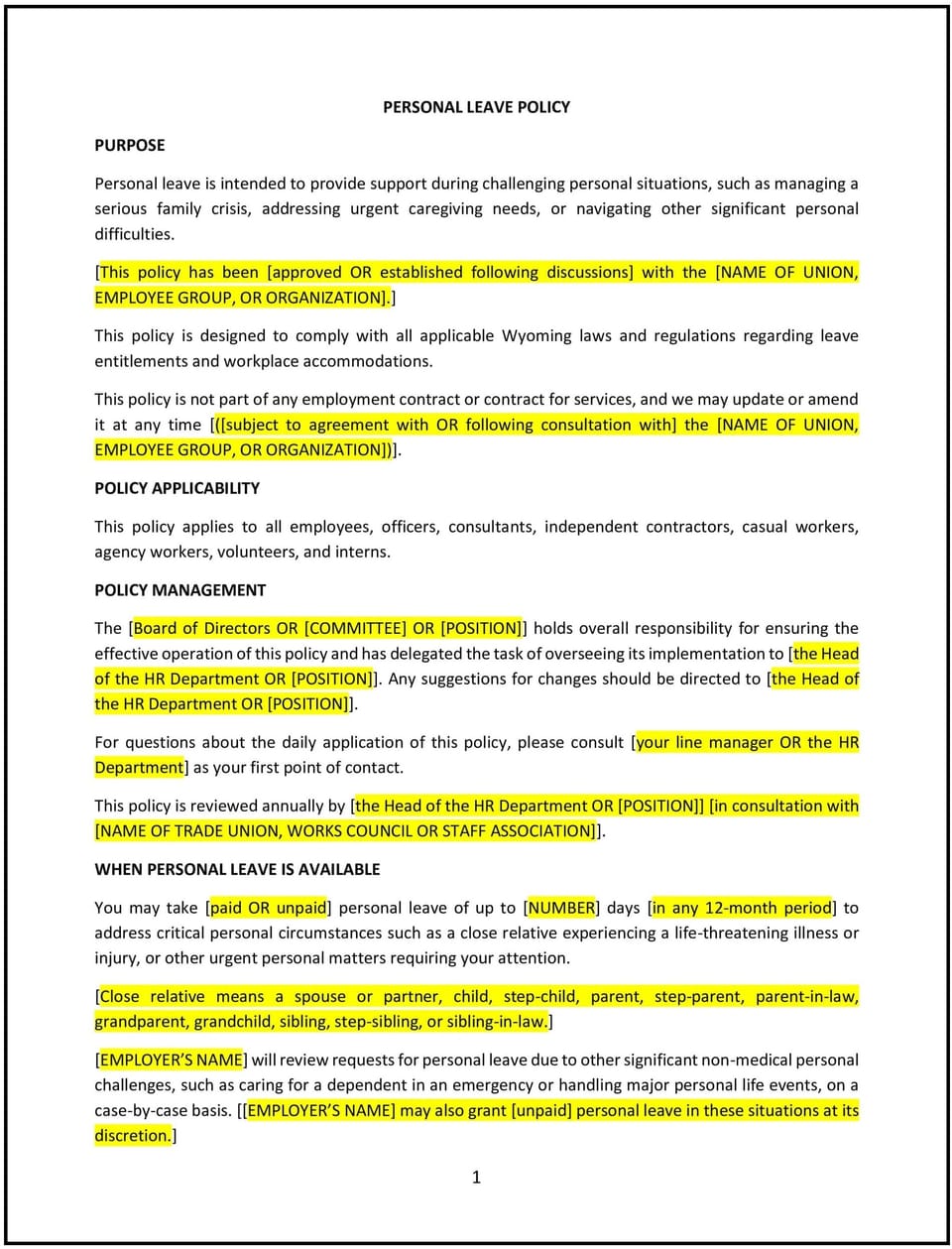Personal leave policy (Wyoming): Free template

Personal leave policy (Wyoming)
In Wyoming, a personal leave policy provides employees with the flexibility to take time off for personal reasons while maintaining clear guidelines for requesting and managing such leave. This policy supports employees’ well-being and work-life balance, fostering a supportive workplace culture.
This policy outlines the eligibility criteria, procedures, and conditions for requesting personal leave, ensuring fairness and consistency.
How to use this personal leave policy (Wyoming)
- Define personal leave: Clearly specify what qualifies as personal leave, such as attending to personal matters, family emergencies, or other non-medical reasons.
- Outline eligibility requirements: State which employees are eligible for personal leave, such as those with a specific tenure or employment status (e.g., full-time or part-time).
- Establish leave duration: Include the maximum duration of personal leave allowed and whether the leave is paid, unpaid, or a combination of both.
- Provide application procedures: Detail the steps for requesting personal leave, such as submitting a formal request to a supervisor or HR and providing any necessary documentation.
- Support compliance: Ensure the policy aligns with Wyoming labor laws and federal regulations to protect employee rights and organizational interests.
Benefits of using a personal leave policy (Wyoming)
A personal leave policy provides several advantages for Wyoming businesses:
- Promotes work-life balance: Allows employees to address personal needs, improving morale and job satisfaction.
- Enhances transparency: Establishes clear guidelines for managing personal leave requests, reducing misunderstandings.
- Supports compliance: Aligns with state and federal labor laws, minimizing the risk of disputes or non-compliance.
- Improves retention: Demonstrates a commitment to employee well-being, fostering loyalty and reducing turnover.
- Adapts to local needs: Reflects Wyoming’s unique workforce dynamics and family-oriented values.
Tips for using a personal leave policy (Wyoming)
- Communicate clearly: Share the policy with employees during onboarding and ensure it is accessible in the workplace.
- Maintain fairness: Apply the policy consistently to all employees to avoid perceptions of favoritism or bias.
- Document requests: Keep accurate records of personal leave requests and approvals to ensure transparency and compliance.
- Encourage communication: Foster open dialogue between employees and supervisors to address leave needs effectively.
- Review regularly: Update the policy to reflect changes in laws, workplace dynamics, or employee feedback.
Q: What qualifies as personal leave under this policy?
A: Personal leave covers non-medical reasons such as family emergencies, personal errands, or other approved absences that do not fall under vacation or sick leave.
Q: Is personal leave paid or unpaid?
A: The policy should specify whether personal leave is paid, unpaid, or a combination, depending on the organization’s guidelines.
Q: How much notice is required to request personal leave?
A: Employees are typically required to provide advance notice unless the leave is due to an unforeseen emergency. The policy should outline specific timelines.
Q: Can personal leave be combined with other types of leave?
A: This depends on the organization’s guidelines. The policy should clarify whether personal leave can be used alongside vacation, sick leave, or other leave types.
Q: How does this policy benefit Wyoming businesses?
A: A personal leave policy fosters a supportive work environment, improves employee satisfaction, and promotes compliance with legal standards, supporting long-term success.
This article contains general legal information and does not contain legal advice. Cobrief is not a law firm or a substitute for an attorney or law firm. The law is complex and changes often. For legal advice, please ask a lawyer.


